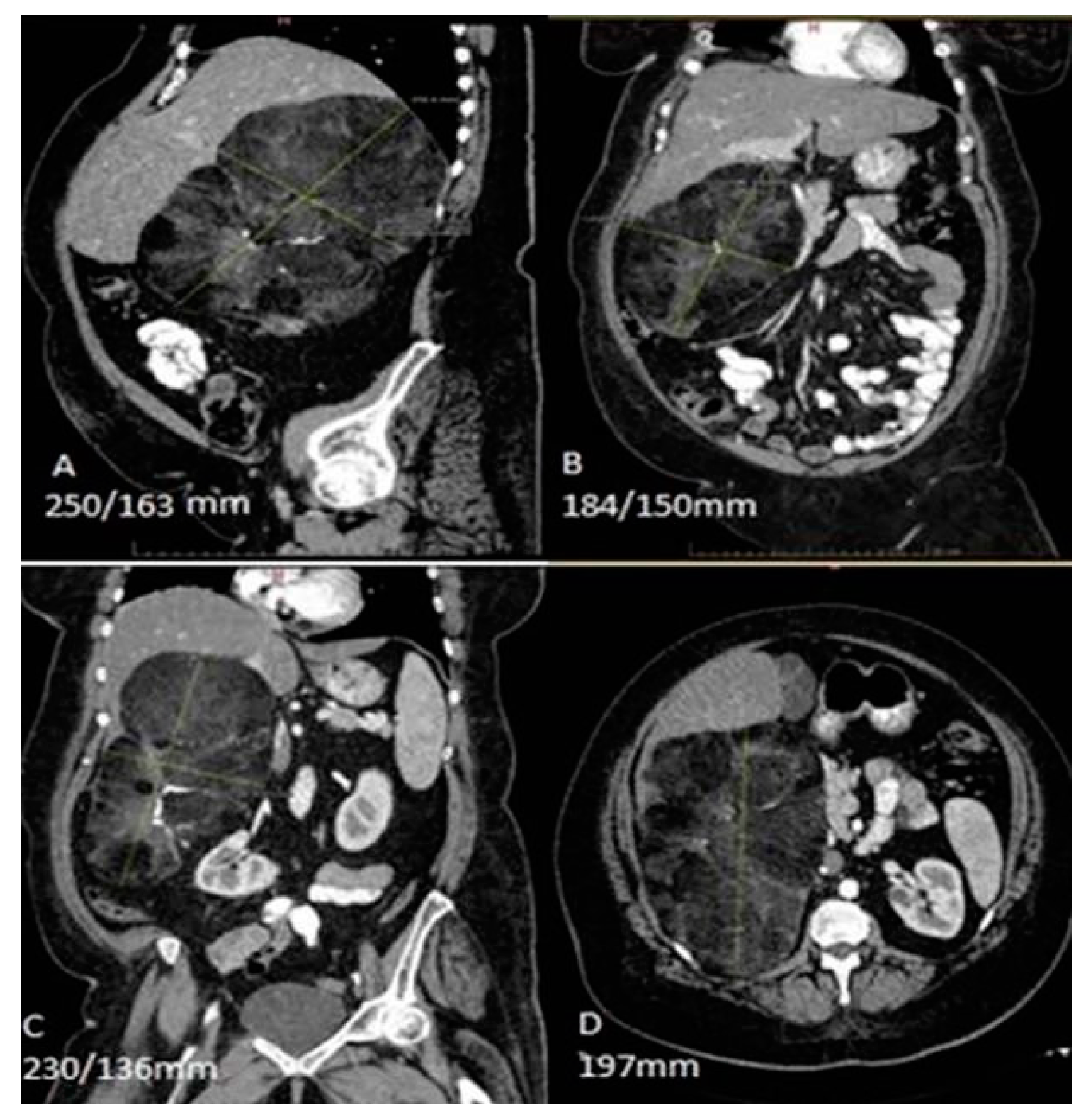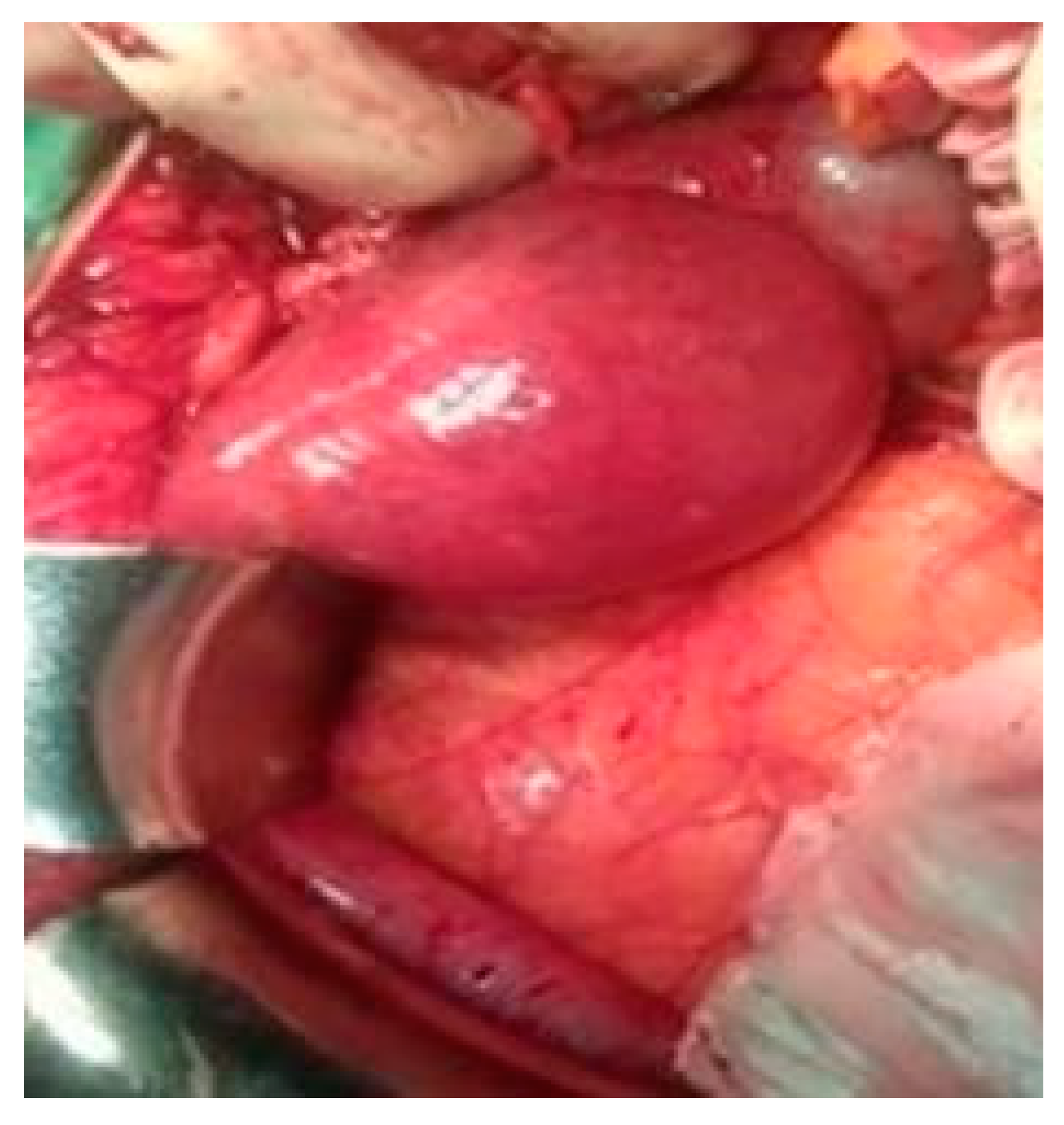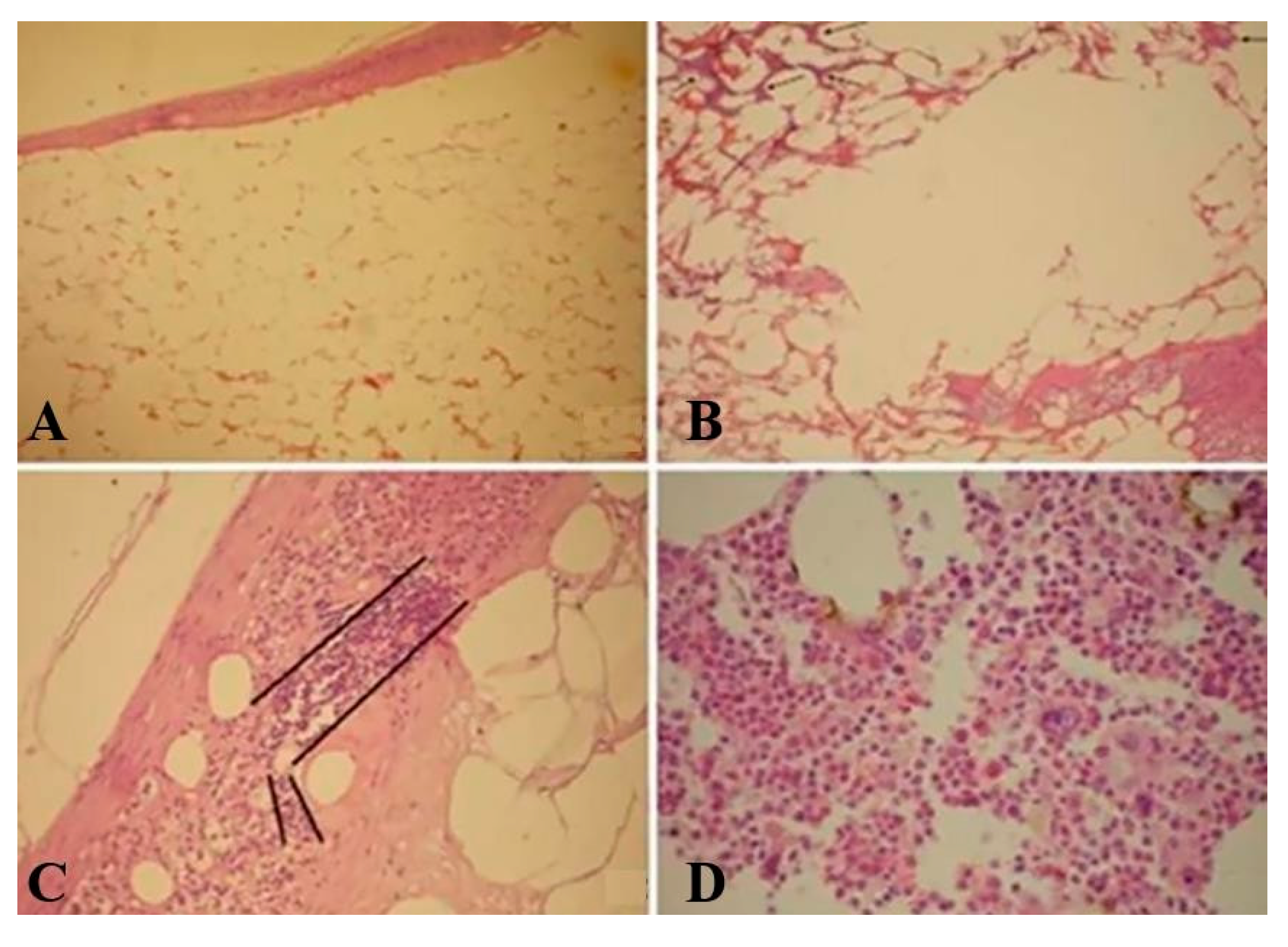Giant Adrenal Myelolipomas: A Literature Review
Abstract
Introduction
Discussions
Diagnostic and surgical management
Conclusions
Compliance with Ethical Standards
Conflicts of Interest
References
- Alvarez, J.F.; Goldstein, L.; Samreen, N.; Beegle, R.; Carter, C.; Shaw, A.; Ben-David, K. Giant adrenal myelolipoma. J Gastrointest Surg. 2014, 18, 1716–1718. [Google Scholar] [CrossRef]
- Gautam, S.; Raafat, H.; Sriganesh, S.; Zaffar, I.; Olude, I.; Komolafe, F.; Qazi, F. Giant adrenal myelolipoma. Qatar Med J. 2013, 2013, 7–11, Published 2013 Nov 1. [Google Scholar] [CrossRef] [PubMed][Green Version]
- Mhammedi, W.A.; Ouslim, H.; Ouraghi, A.; Irzi, M.; Elhoumaidi, A.; Chennoufi, M.; Mokhtari, M.; Elmouden, A.; Barki, A. Adrenal myelolipoma: From tumorigenesis to management. Pan Afr Med J. 2019, 34, 180, Published 2019 Dec 5. [Google Scholar] [CrossRef] [PubMed]
- Nikumbh, D.B.; Kshirsagar, A.Y.; Desai, S.R.; Shrigondekar, P.A.; Mali, R.K.; Wader, J.V. Giant adrenal myelolipoma. The American Journal of Case Reports. 2011, 12, 83–86. [Google Scholar] [CrossRef]
- Fernandes, G.C.; Gupta, R.K.; Kandalkar, B.M. Giant adrenal myelolipoma. Indian J Pathol Microbiol. 2010, 53, 325–326. [Google Scholar] [CrossRef]
- Akamatsu, H.; Koseki, M.; Nakaba, H.; Sunada, S.; Ito, A.; Teramoto, S.; Miyata, M. Giant adrenal myelolipoma: Report of a case. Surg Today. 2004, 34, 283–285. [Google Scholar] [CrossRef]
- Adapa, S.; Naramala, S.; Gayam, V.; Gavini, F.; Dhingra, H.; Hazard, F.K.G.; Aeddula, N.R.; Konala, V.M. Adrenal Incidentaloma: Challenges in Diagnosing Adrenal Myelolipoma. J Investig Med High Impact Case Rep. 2019, 7, 2324709619870311. [Google Scholar] [CrossRef]
- Répássy, D.L.; Csata, S.; Sterlik, G.; Iványi, A. Giant adrenal myelolipoma. Pathol Oncol Res. 2001, 7, 72–73. [Google Scholar] [CrossRef]
- Rafiq, B.; El Mghari, G. Myélolipome de la surrénale: À propos d’un cas [Adrenal myelolipoma: About a case]. Pan Afr Med J. 2017, 28, 153. [Google Scholar] [CrossRef]
- Daneshmand, S.; Quek, M.L. Adrenal myelolipoma: Diagnosis and management. Urol, J. 2006, 3, 71–74. [Google Scholar]
- D’Addosio, R.; Rojas, J.; Bermúdez, V.; Ledesma, F.; Hoedebecke, K. Case Report: An incidentaloma that catches your eye—Adrenal myelolipoma. F1000Res. 2017, 6, 1140, Published 2017 Jul 18. [Google Scholar] [CrossRef] [PubMed]
- Guillaume, L.; Borght, T.V.; Bertrand, C.; Dupont, M.; Krug, B. Presacral Myelolipoma: The Usefulness of a 99mTc-Albumin Nanocolloid Scintigraphy. Clin Nucl Med. 2021, 46, 38–39. [Google Scholar] [CrossRef]
- Yildiz, L.; Akpolat, I.; Erzurumlu, K.; Aydin, O.; Kandemir, B. Giant adrenal myelolipoma: Case report and review of the literature. Pathol Int. 2000, 50, 502–504. [Google Scholar] [CrossRef] [PubMed]
- Xin, H.; Li, H.; Yu, H.; Zhang, J.; Peng, W.; Peng, D. MR imaging to detect myelolipomas of the liver: A case report and literature review. Medicine 2019, 98, e16497. [Google Scholar] [CrossRef]
- Brogna, A.; Scalisi, G.; Ferrara, R.; Bucceri, A.M. Giant secreting adrenal myelolipoma in a man: A case report. J Med Case Rep. 2011, 5, 298, Published 2011 Jul 9. [Google Scholar] [CrossRef] [PubMed]
- Rahoui, M.; Ouanes, Y.; Chaker, K.; Dali, K.M.; Bibi, M.; Sellami, A.; Ben Rhouma, S.; Nouira, Y. Giant adrenal myelolipoma in a young female patient: A case report. J Surg Case Rep. 2022, 2022, rjac213. [Google Scholar] [CrossRef]
- Lamont, J.P.; Lieberman, Z.H.; Stephens, J.S. Giant adrenal myelolipoma. Am Surg. 2002, 68, 392–394. [Google Scholar] [CrossRef]
- Şavlovschi, C.; Comandaşu, M.; Şerban, D. Particularities of Diagnosis and Treatment in Synchronous Colorectal Cancers (SCC). Chirurgia 2013, 108, 43–45. [Google Scholar]
- Hamidi, O.; Raman, R.; Lazik, N.; Iniguez-Ariza, N.; McKenzie, T.J.; Lyden, M.L.; Thompson, G.B.; Dy, B.M.; Young, W.F.; Bancos, I. Clinical course of adrenal myelolipoma: A long-term longitudinal follow-up study. Clin Endocrinol 2020, 93, 11–18. [Google Scholar] [CrossRef]
- Ramesh, R.; Roger, B.; Dhali, A.; Dsouza, C. Giant Bilateral Adrenal Myelolipoma: Case Report. Indian J Endocrinol Metab. 2020, 24, 551–553. [Google Scholar] [CrossRef]
- Gupta, S.S.; Kupfer, Y. Giant Bilateral Adrenal Myelolipoma. Balkan Med, J. 2017, 34, 476–477. [Google Scholar] [CrossRef] [PubMed]
- Nitz, J.A.; Huckleby, J.; Hwang, E.H.; Medina, M.G.; Pera, S.J.; Orcutt, S.T. Symptomatic Extra-Adrenal Myelolipoma in the Spleen. Case Rep Surg. 2020, 2020, 8839178. [Google Scholar] [CrossRef] [PubMed]
- Higgs, J.A.; Quinn, A.P.; Seely, K.D.; Richards, Z.; Mortensen, S.P.; Crandall, C.S.; Brooks, A.E. Pathophysiological Link between Insulin Resistance and Adrenal Incidentalomas. Int J Mol Sci. 2022, 23, 4340, Published 2022 Apr 14. [Google Scholar] [CrossRef]
- Prete, A.; Subramanian, A.; Bancos, I.; Chortis, V.; Tsagarakis, S.; Lang, K.; Macech, M.; Delivanis, D.A.; Pupovac, I.D.; Reimondo, G.; et al. Cardiometabolic Disease Burden and Steroid Excretion in Benign Adrenal Tumors: A Cross- Sectional Multicenter Study. Ann Intern Med. 2022, 175, 325–334. [Google Scholar] [CrossRef]
- Toader, S.; Pavel, O.; Barsan, S.; Olariu, R.; Grigorescu, D.O.; Penciu, M.; Nagy, A.L.; Georgescu, A.V.; Baldea, B.I. The influence of diabetes mellitus on survival of abdominal perforator flaps: An experimental study in rats with slowly induced diabetes mellitus. J Reconstr Microsurg. 2015, 31, 145–153. [Google Scholar] [CrossRef][Green Version]
- Wang, F.; Liu, J.; Zhang, R.; Bai, Y.; Li, C.; Li, B.; Liu, H.; Zhang, T. CT and MRI of adrenal gland pathologies. Quant Imaging Med Surg. 2018, 8, 853–875. [Google Scholar] [CrossRef] [PubMed]
- Cho, M.H.; Mandaliya, R.; Liang, J.; Patel, M. A case report of symptomatic presacral myelolipoma. Medicine 2018, 97, e0337. [Google Scholar] [CrossRef]
- Ramdani, A.; Aissaoui, A.; Bouhout, T.; Bennani, A.; Latrech, H.; Serji, B.; El Harroudi, T. Giant symptomatic adrenal myelolipoma: A case report. Ann Med Surg 2022, 75, 103333, Published 2022 Feb 9. [Google Scholar] [CrossRef]
- Cho, J.; Kinsey, D.; Kimchi, E.T.; O'Carroll, K.S.; Nguyen, V.; Alsabbagh, M.; Gaballah, A. Retroperitoneal extra-adrenal myelolipoma misdiagnosed as liposarcoma: A case report. Radiol Case Rep. 2020, 16, 364–368. [Google Scholar] [CrossRef]
- Reginelli, A.; Vacca, G.; Belfiore, M.; Sangiovanni, A.; Nardone, V.; Vanzulli, A.; Grassi, R.; Cappabianca, S. Pitfalls and differential diagnosis on adrenal lesions: Current concepts in CT/MR imaging: A narrative review. Gland Surg. 2020, 9, 2331–2342. [Google Scholar] [CrossRef]
- Jun, J.H.; Ahn, H.J.; Lee, S.M.; Kim, J.A.; Park, B.K.; Kim, J.S.; Kim, J.H. Is Preoperative Biochemical Testing for Pheochromocytoma Necessary for All Adrenal Incidentalomas? Medicine 2015, 94, e1948. [Google Scholar] [CrossRef] [PubMed]
- Mateescu, M.-C.; Grigorescu, S.; Socea, B.; Bloanca, V.; Grigorescu, O.-D. Contribution to the Personalized Management of the Nosocomial Infections: A New Paradigm Regarding the Influence of the Community Microbial Environment on the Incidence of the Healthcare-Associated Infections (HAI) in Emergency Hospital Surgical Departments. J Pers Med. 2023, 13, 210, Published 2023 Jan 25. [Google Scholar] [CrossRef]
- Grigorescu, S.; Cazan, A.-M.; Rogozea, L.; Grigorescu, D.O. Predictive Factors of the Burnout Syndrome Occurrence in the Healthcare Workers During the COVID-19 Pandemic. Front. Med. 2022, 9, 842457. [Google Scholar] [CrossRef] [PubMed]
- Campbell, M.J.; Obasi, M.; Wu, B.; Corwin, M.T.; Fananapazir, G. The radiographically diagnosed adrenal myelolipoma: What do we really know? Endocrine 2017, 58, 289–294. [Google Scholar] [CrossRef]
- Allison, K.H.; Mann, G.N.; Norwood, T.H.; Rubin, B.P. An unusual case of multiple giant myelolipomas: Clinical and pathogenetic implications. Endocr Pathol. 2003, 14, 93–100. [Google Scholar] [CrossRef]
- Doddi, S.; Singhal, T.; Leake, T.; Sinha, P. Management of an incidentally found large adrenal myelolipoma: A case report. Cases J. 2009, 2, 8414, Published 2009 Sep 3. [Google Scholar] [CrossRef]
- Decmann, Á.; Perge, P.; Tóth, M.; Igaz, P. Adrenal myelolipoma: A comprehensive review. Endocrine. 2018, 59, 7–15. [Google Scholar] [CrossRef]




© 2024 by the authors. Licensee MDPI, Basel, Switzerland. This article is an open access article distributed under the terms and conditions of the Creative Commons Attribution (CC BY) license (https://creativecommons.org/licenses/by/4.0/).
Share and Cite
Hogea, M.; Hogea, A.; Moga, M.; Dragomir, R.; Grigorescu, S.; Socea, B. Giant Adrenal Myelolipomas: A Literature Review. J. Mind Med. Sci. 2024, 11, 345-350. https://doi.org/10.22543/2392-7674.1522
Hogea M, Hogea A, Moga M, Dragomir R, Grigorescu S, Socea B. Giant Adrenal Myelolipomas: A Literature Review. Journal of Mind and Medical Sciences. 2024; 11(2):345-350. https://doi.org/10.22543/2392-7674.1522
Chicago/Turabian StyleHogea, Mircea, Anda Hogea, Marius Moga, Roxana Dragomir, Simona Grigorescu, and Bogdan Socea. 2024. "Giant Adrenal Myelolipomas: A Literature Review" Journal of Mind and Medical Sciences 11, no. 2: 345-350. https://doi.org/10.22543/2392-7674.1522
APA StyleHogea, M., Hogea, A., Moga, M., Dragomir, R., Grigorescu, S., & Socea, B. (2024). Giant Adrenal Myelolipomas: A Literature Review. Journal of Mind and Medical Sciences, 11(2), 345-350. https://doi.org/10.22543/2392-7674.1522


